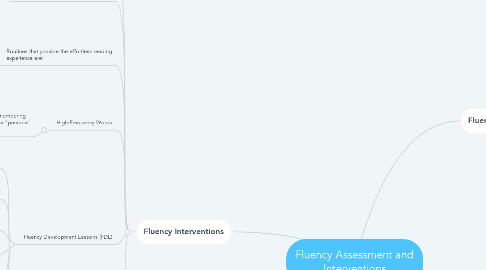
1. Fluency Interventions
1.1. This comes after you have collected and analyzed data on the variables that comprise fluency.
1.2. Students reading will require some effort and concentration but they also need to do some reading that is effortless
1.3. Routines that provide the effortless reading experience are:
1.3.1. Modeling, this can be done by reading aloud
1.3.2. Allow purposes for easy reading, such as having older children read books to younger buddies
1.3.3. Allow children to make tape recordings of favorite books
1.3.4. Make the expanding world of easy nonfiction picture books readily available
1.4. High-Frequency Words
1.4.1. Students who struggle remembering common words can have a "personal portable word wall"
1.5. Fluency Development Lessons (FDL)
1.5.1. Step 1: Teacher reads aloud a short passage several times, modeling fluent reading
1.5.2. Step 2: Teacher and class do a choral reading, several times, with different children reading different parts
1.5.3. Step 3: Children are paired and take turns reading to each other. Each child will read the passage 3 times
1.5.4. Step 4: Class gathers together, children volunteer to read aloud to the whole class
1.5.5. Step 5: Each child chooses 2-3 words to add to their personal word banks
1.5.6. Step 6: Children take home a copy of the short passage and read to whoever will listen at home
1.5.7. Step 7: Next day, passage is read again and cycle begins with new passage
1.6. Fluency Oriented Reading Instruction (FORI)
1.6.1. Much like FDL, but FORI has longer passages.
1.6.2. Day 1: Teacher reads aloud while students silently follow along in their books. Story is discussed and teacher builds vocabulary, comprehension, and other strategies related to the story
1.6.3. Day 2: Teacher and students echo read the story. Students do comprehension activity, usually write a short response. Students take the story home to read to a family member.
1.6.4. Day 3: Students and teacher do a choral reading of the story.
1.6.5. Day 4: Students read with a partner, taking turns reading each page.
1.6.6. Day 5: Final day, students do some extension activities related to the story.
2. Fluency Is More Than Speed
2.1. In addition to speed and accuracy, fluency always includes expression.
2.2. Once you have identified what you want to assess and have collected data, you analyze the evidence then decide what to do based on your analyses.
2.3. To validly assess fluency, you need to collect information on speed, accuracy, expression, and comprehension and analyze the results of your data.
3. Extending One-Minute Measures to Truly Measure Fluency
3.1. You can modify the measures you are now using and collect data that will allow you to make valid decisions about the progress and needs of students.
3.2. After the student is done reading, have them retell what they read and rate their comprehension to ensure your student is reading and thinking about comprehension.
3.2.1. Before they read, you can tell them you want them to be able to tell you what they read when they finish reading.
3.3. Measuring Accuracy
3.3.1. make a record of the errors the students make. Strike through any omitted words, substitutions, or mispronunciations
3.3.1.1. Put "H" for any words they hesitate on and correctly decode
3.3.2. A good sign is when a students makes an error then goes back and self corrects, it shows they are monitoring their reading.
3.3.2.1. Can use "SC" for self correction. Any words that are self-corrected do not count as errors.
3.4. Measuring Expression
3.4.1. Listen for students phrasing and expression as they read. Rate on a expression scale
3.4.1.1. Level 4: reads phrases with expression that sounds like a speech
3.4.1.2. Level 3: Reads in mostly phrases with some expression
3.4.1.3. Level 2: Reads mostly word by word, with some phrases but little expression
3.4.1.4. Level 1: Reads like reading words in a list, little or no expression
3.5. Measuring Comprehension
3.5.1. Rate on comprehension scale
3.5.1.1. Level 4: Recalls most of the important events, no misinformation
3.5.1.2. Level 3: Recalls a lot of events, little misinformation
3.5.1.3. Level 2: Recalls some events and some misinformation
3.5.1.4. Level 1: Recalls little except the topic
